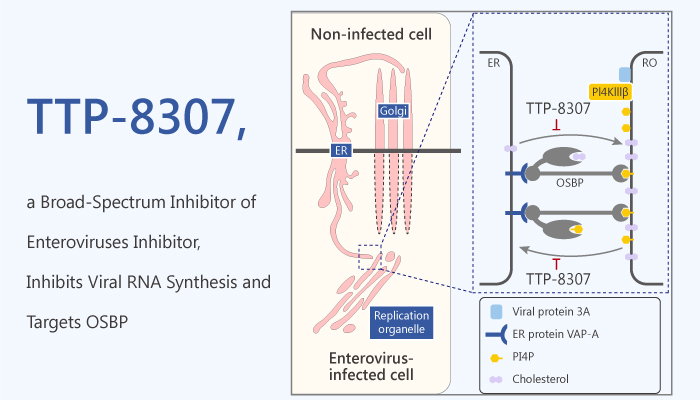Enteroviruses comprise several pathogens. They cause a large variety of clinical manifestations that range from mild illnesses to more serious or even life-threatening diseases. They include meningitis, encephalitis, myocarditis, pancreatitis, acute paralysis, and neonatal sepsis. Enteroviruses are small, nonenveloped, and spherical in shape. The enteroviral genome consists of a single-stranded, positive-sense RNA. The coding region of the viral genome has three primary precursor molecules. They contain the four structural and 10 nonstructural viral proteins. The nonstructural protein 3A and its precursor 3AB are derived from P3 and are indispensable for viral replication. The 3B protein then serves as a primer for the initiation of RNA synthesis, probably only after it has been cleaved from the 3A portion and not when it is still in the 3AB membrane-bound state. In this study, TTP-8307 is a potent inhibitor of the replication of several rhino- and enteroviruses.
TTP-8307 is an inhibitor of the replication of several rhino- and enteroviruses and exerts antiviral activity through oxysterol-binding protein (OSBP).

TTP-8307 inhibits the replication of coxsackievirus B3 and the three poliovirus Sabin strains, as well as coxsackieviruses A16 and A21. Moreover, TTP-8307 inhibits human rhinoviruses (HRVs) 2, 29, 39, 45, 63, and 85. TTP-8307 inhibits CVB3 replication in a dose-dependent manner. In addition, TTP-8307 acts at a stage that coincides with CVB3 viral RNA replication and polyprotein synthesis/processing. Meanwhile, TTP-8307 inhibits the accumulation of CVB3 viral RNA. In addition, the antiviral activity of TTP-8307 extends to other viruses that require OSBP, namely the picornavirus encephalomyocarditis virus and the flavivirus hepatitis C virus.
In summary, TTP-8307 potently inhibits the replication of several enteroviruses, including coxsackievirus B3 and poliovirus by interfering with the synthesis of viral RNA. Thus, TTP-8307 might be is an interesting compound for lead optimization, given its potent inhibitory effect on the replication of the three PV Sabin strains.
Reference:
De Palma AM, et al. Antimicrob Agents Chemother. 2009 May;53(5):1850-7.